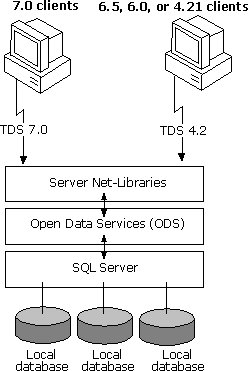
The server components of Microsoft® SQL Server™ receive SQL statements from clients and process those SQL statements. This illustration shows the major components involved with processing an SQL statement received from a SQL Server client.

SQL statements are sent from clients by using an application-level protocol specific to SQL Server called Tabular Data Stream (TDS). SQL Server version 7.0 accepts two versions of TDS:
TDS packets are built by the Microsoft OLE DB Provider for SQL Server, the SQL Server ODBC driver, or the DB-Library DLL. The TDS packets are then passed to a SQL Server client Net-Library, which encapsulates the TDS packets into network protocol packets. On the server, the network protocol packets are received by a server Net-Library that extracts the TDS packet and passes it to Open Data Services.
This process is reversed when results are returned to the client.
Each server can be simultaneously listening on several network protocols and will be running one server Net-Library for each protocol it is listening on.
Open Data Services is the component that manages all the TDS packets coming from the server Net-Libraries. Open Data Services determines the type of each TDS packet (login packet, SQL statement execution, or remote stored procedure call) and then calls the appropriate function in SQL Server.
The database server processes all requests passed to it from Open Data Services. It compiles all the SQL statements into execution plans, then uses the plans to access the requested data and build the result set returned to the client.
| Client/Server Architecture |